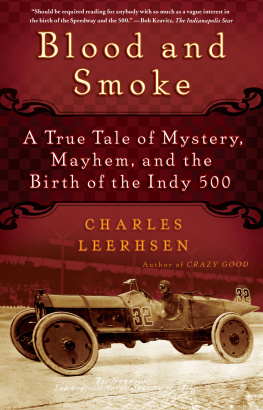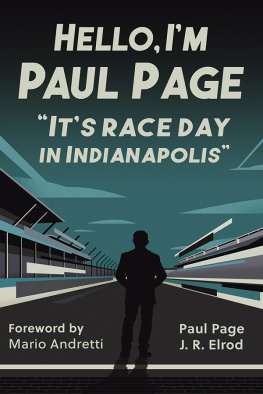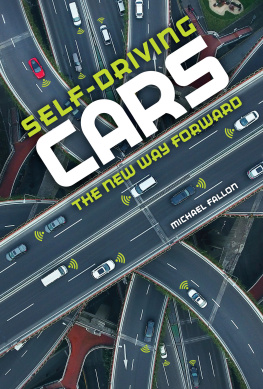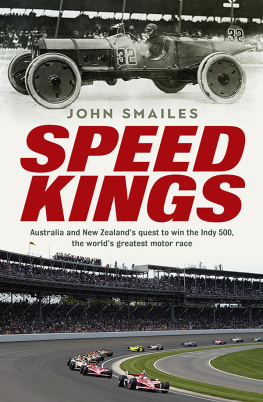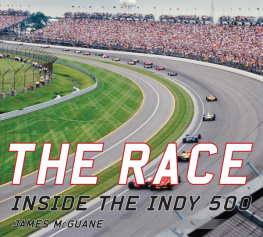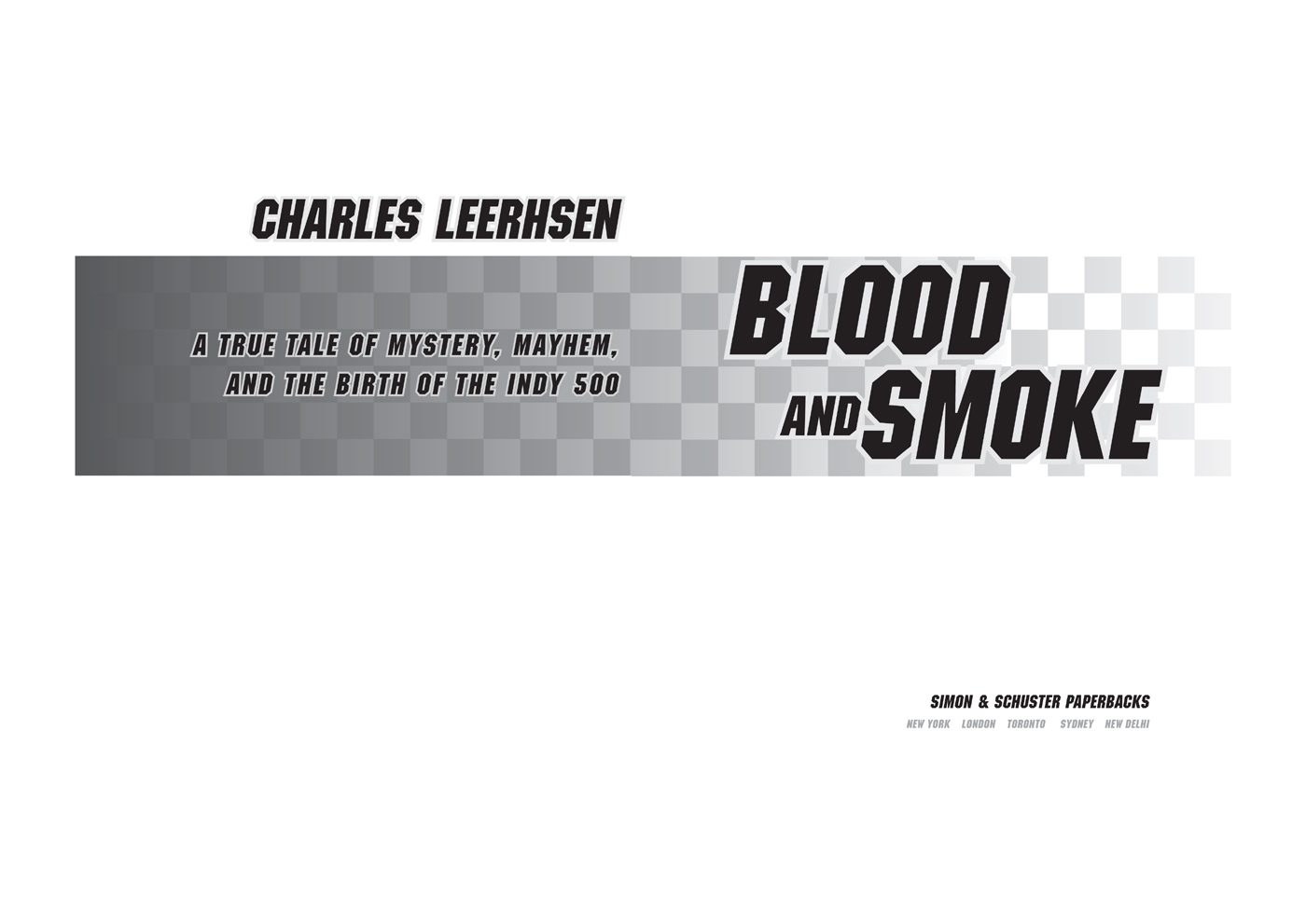Thank you for downloading this Simon & Schuster eBook.
Join our mailing list and get updates on new releases, deals, bonus content and other great books from Simon & Schuster.
C LICK H ERE T O S IGN U P
or visit us online to sign up at
eBookNews.SimonandSchuster.com

FOR ADELE LEERHSEN, MY MOM
Behind them was a past forever destroyed, still quivering on its ruins with all the fossils of the centuries of absolutism; before them the dawn of a vast horizon, the first glimmerings of the future; and between these two worlds, like the ocean that separates the Old World from young America, something vague and floating, a stormy sea full of wreckage, traversed from time to time by some far-off white sail or some ship puffing heavy smokein short, the present century.
ALFRED DE MUSSET,
The Confession of a Child of the Century
Gentlemen, start your coffins.
JIM MURRAY , Los Angeles Times

ALL THESE YEARS later his heart still swells with pride for his father, who won the Indianapolis 500-mile race. When he opens the door of his place down near Orlando, the son doesnt so much greet you as present you with his smooth and pleasant face, turning it a bit this way then that, wanting you to notice how closely he resembles Dad. You gasp obligingly, and he smiles, as in a card trick.
The son says he is waiting for the cleaning lady but the house is immaculate. The father was fastidious, small-built, and dapper with a pencil mustachelike a lot of race car drivers of his dayand the house is a fitting shrine to him, though he never lived here himself. Scattered throughout the rooms are framed photographs of Dad, miniature automobiles, laminated documents, scrapbooks with crumbling clippings from long-gone barbershop magazines ( Argosy, Saga, True ) and even yellower telegrams of congratulation. When you win the Indianapolis 500, people start laminating your documents, and it just goes on from there.
ONCE, ACROSS VAST swaths of America, the race was the most anticipated event on the calendar apart from Christmas. Every Memorial Day as many as 400,000 spectators packed themselves into the Speedway, a two-and-a-half-mile rectangle (with curved corners) located not in Indianapolis, technically, but in Speedway, Indiana (pop. 12,594), a suburb about five miles northwest of the capital. The mobs were no doubt drawn to the race in part by the loud and sexy cars and the (usually) quiet and (by definition) sexy men who drove them at speeds of 75, then 150, and, as the years went by, well above 200 miles per hour. Americans love cars, of course, and speed and competition, and sunshine and pork tenderloin sandwiches, but no one has ever been able to explain exactly why so many people feel so passionately about this particular race, which involves esoteric machines and arcane feats of mechanical engineering as well as the occasional fiery deathand which does not even determine the championship of the Indy car circuit. I dont know why Indy became such a phenomenon, former Speedway president Joe Cloutier once said, but I do know its a fragile formula that we dont want to mess with.
Until 1986 not messing with the formula meant keeping the best-attended sports event in America off live national TV, the better to preserve that robust gate. So in the 60s and 70s, as the cool, low-slung roadsters gave way to fierce-looking rear-engine racers, and the Speedway found itself flooded with future immortals like A.J. Foyt (four wins), Al Unser (four) and his brother Bobby (three), Johnny Rutherford (three), and Mario Andretti (just one, but God what great hair), the only way for most people to see the race as it happened was to see it on radio. Crowding around the portable at the Memorial Day picnic, shushing each other while announcers Sid Collins and later Paul Page described the action, became for millions a rite of late middle-American spring. Indeed like most other things forbidden to the eye, the race in this accidental way gained a potent extra allure.
To win the Indy 500 was a glorious, life-changing event that severely tested the winners ability to handle money, media, and awe. The stakes for a driver are so high, in terms of money and prestige, that it heightens the danger, Sam Posey, who finished fifth in the 1972 Indy 500, once said. Theres never a moment that you relax at the Speedway, never a moment when you get past the possibility of something really insane happening. I mean, who cares if you win at Trenton? Winning the 500 was a distinction comparable to being the heavyweight champion in the era before that division was merely a merry-go-round of revolving Russians. You walked into a restaurant and someone sent drinks to your table and every once in a while someone threw a drink in your facethe ultimate compliment, really, when your only offense was being just too much for the drink flinger to handleyour famous face now a glorious bump, like that of all the other winners, on the silver Borg-Warner trophy. The radio monologist Jean Shepherd, who grew up in Hammond, Indiana, observed in the early 1970s that all retired Indy winners have a sadness around their eyes, because they know they can never win the 500 again. The rush of victory at the place they call the Brickyard does seem highly addictive. Two winners, Floyd Roberts and Bill Vukovich, died on the track while trying for a second and third Indy, respectively. The 1924 co-winner, Lora Corum, hanged himselfthough that is a complicated story, his suicide coming many years after the disgrace of being fired after the 109th lap by car owner Fred Duesenberg, who replaced him on the spot with the more aggressive Joe Boyer (who won the race but died on another track just a few months later). Even if winning at Indy doesnt change you forever it will change forever the way other men see you. It will change the way women see you, too. The father of the son in Orlando, for example, was married five times.
Baby boomers, those masters and slaves of nostalgia, will point to the 60s and 70s as the best of times at Indy, but the matter is hardly settled. You could make a case for the 1980s, an era of dramatic duels (see, for example, Danny Sullivans 1985 spin-and-win victory over Andretti, and the ballsy wheel-brush with which Emerson Fittipaldi finally shook off Al Unser Jr. with four laps to go in 89) and sleek, curvaceous cars that looked like they were going 230 mph when they were sitting in the pits (the record for the fastest race lap, set in 1996, is 236.103 mph). These one-off speed machines would later be outlawed by a governing body, the Indy Racing League, concerned about safety, yes, but perhaps just as much about the cost to the car owners of constantly pushing the borders of technology and design. Still, the very real possibility that the machines in those years might at any moment become airborne and fly into the stands seemed to scare away no one. Quite the opposite, actually. Not only would 400,000 come to watch the race in the mid-80s, but nearly 200,000 routinely turned out the day before (Carburetion Day, as it is still known, though no Indy car has had a carburetor since 1991) to see the final tune-ups. Perhaps the one legitimate knock against the 80s as the true Glory Days is that the then new generation of driversa group led by Bobby Rahal, Tom Sneva, and especially Rick Mears, who won four 500s between 79 and 91were more competent than charismatic, the vanguard of the all too vanilla era lying just around the next turn.
Next page
